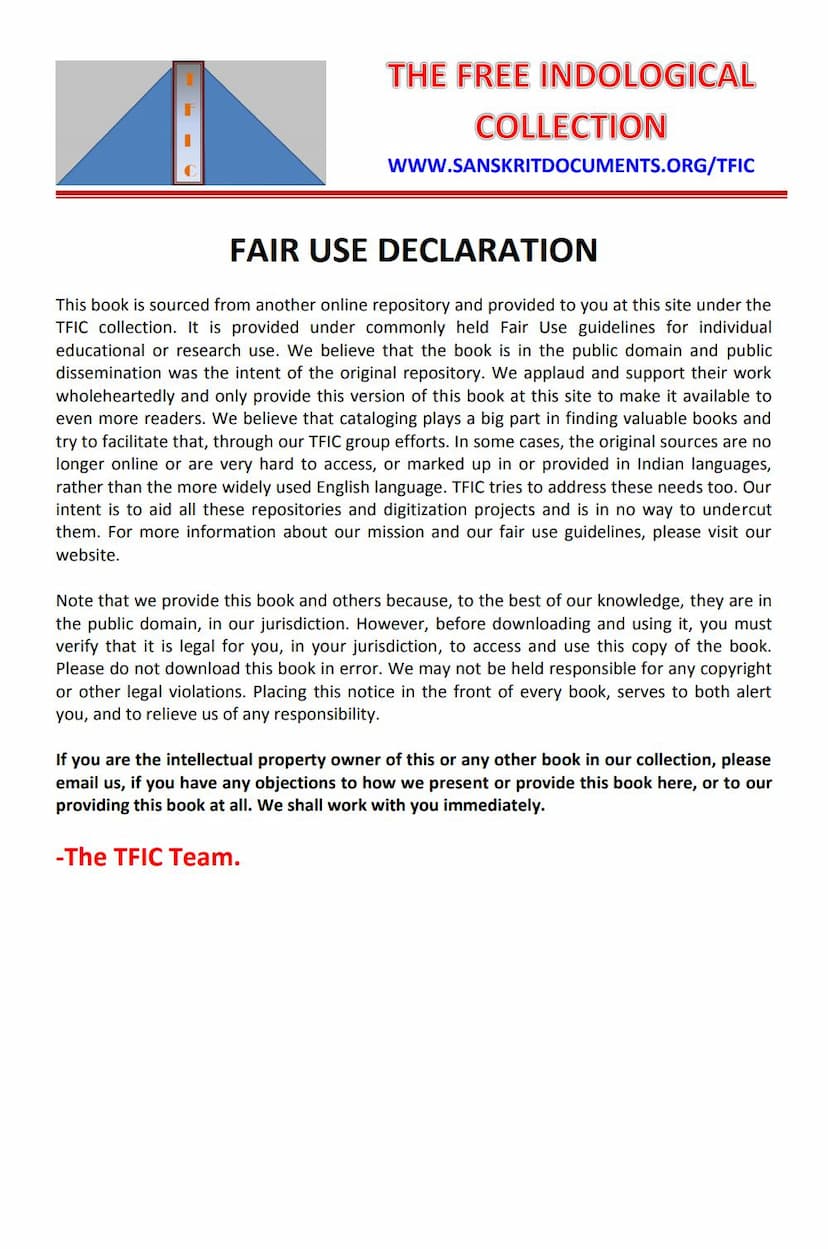Jaina Art And Architecture Vol 01
Added to library: September 2, 2025

Summary
Here's a comprehensive summary of "Jaina Art and Architecture, Vol. 1" by A. Ghosh, published by Bharatiya Gyanpith:
This volume, published on the occasion of the 2500th Nirvana Anniversary of Tirthankara Mahavira, is the first comprehensive work dedicated exclusively to the art and architecture produced under the aegis of Jainism. It aims to provide a detailed overview of this significant aspect of Indian cultural heritage, acknowledging that Jaina art and architecture are intrinsically linked to the broader mainstream of Indian art, while also possessing unique characteristics derived from Jainism's distinct religious and mythological concepts.
The book emphasizes that while Jaina art follows the stylistic evolution of its respective periods and regions, it also incorporates specific Jaina iconographic features and thematic representations like the samavasarana and Nandiśvara-dvipa. The publication highlights the integral role of Jainism in enriching Indian philosophy, literature, and the pattern of living, and aims to make this rich artistic and architectural legacy accessible to scholars and the general public alike. Bharatiya Jnanpith's extensive archive of over ten thousand photographs collected for this project further supports this objective.
The volume is structured into several parts:
Part I: Introduction This section sets the stage for the study of Jaina art and architecture, featuring:
- Editorial Observations by A. Ghosh: The editor highlights the necessity of a comprehensive work on Jaina art and architecture, noting its significant contribution to Indian culture. He emphasizes that Jaina art, while sharing stylistic traits with other Indian art forms, also reflects Jaina religious and mythological specifics. Ghosh discusses the historical evolution of Jaina art, its relationship with Buddhism and Brahmanism, and the artistic freedom and constraints faced by artists within the Jaina tradition. He also touches upon the publication's genesis, challenges, and editorial responsibilities.
- The Background and Tradition by M. N. Deshpande: This chapter delves into the historical and philosophical underpinnings of Jainism, outlining the twenty-four Tirthankaras, their attributes, and the chronological context of key figures like Pārsvanātha and Mahavira. It explores the antiquity of asceticism in India, highlighting the distinctiveness of Jaina ascetic practices and the potential Harappan connections to Jaina traditions.
- The Expansion of Jainism by S. B. Deo: This chapter traces the geographical and historical spread of Jainism from its origins in Bihar across north and central India, and into the Deccan and south India. It discusses the patronage of Jainism by various rulers and communities, the schisms within the faith (particularly the Digambara-Svetambara divide), and the establishment of Jaina centers in different regions.
- The Genesis and Spirit of Jaina Art by Jyoti Prasad Jain: This chapter examines the underlying philosophy and spirit of Jaina art, emphasizing its role in the spiritual perfection of humanity. It discusses how Jaina art, while serving religious purposes and softening austerity, reflects the creed's puritanical character by avoiding eroticism and vulgarity. The chapter also touches upon the significance of pilgrimage sites and the aesthetic and ethical appeal of Jaina sculptures and architectural forms.
- The Ethical Background by A. N. Upadhye: This chapter focuses on the ethical framework of Jainism and its reflection in Jaina art and architecture. It explains the Jaina concept of divinity, worship, and the goals of spiritual development. The chapter details how Jaina ethics, such as non-violence, truthfulness, and detachment, are conveyed through miniature paintings, cave temples, sculptures, and temple architecture, aiming to elevate the spirit and inspire moral conduct.
Part II: Monuments & Sculpture 300 B.C. to A.D. 300 This section provides a detailed account of early Jaina artistic and architectural manifestations:
- Mathura by Debala Mitra: Mathura is presented as a significant early center for Jainism, with archaeological evidence pointing to its firm footing by the second century B.C. The chapter discusses the various Jaina relics found at Kankali-tila, including components of stupas, railings, gateways, and ayaga-patas, illustrating the artistic evolution and patronage during the pre-Kushan and Kushan periods. It also examines early Jina images, Yakshi Aryavati, and the goddess Sarasvati, highlighting the early development of Jaina iconography.
- East India by Debala Mitra: This chapter focuses on the early Jaina presence in Bihar, West Bengal, and Orissa. It details the rock-cut caves at Rajgir (Sonbhandar), the significant Mauryan period Jaina torsos from Lohanipur, and the bronze hoard from Chausa in Bihar. For West Bengal, it notes the scant early remains but mentions the historical significance of the region for Jainism. In Orissa, the chapter highlights the importance of the Udayagiri and Khandagiri caves as early Jaina monastic retreats, discussing their architecture, Brahmi inscriptions, and later sculptures, as well as the historical context of King Kharavela's patronage.
- West India by Umakant P. Shah: This chapter explores the early Jaina presence in western India, noting the scarcity of definitively dated monuments from the Mauryan or Sunga periods. It discusses the literary traditions associating Jainism with Ujjain and Saurashtra, and highlights the potential Jaina origins of the Bawa-Pyara's Math caves at Junagadh. The chapter also touches upon early Jaina activity in Sindhu-Sauvira and the significance of the princeps text Vasudeva-hindi. The early bronze of Pārsvanātha in the Prince of Wales Museum is discussed for its Indus-style modeling.
- South India by R. Champakalakshmi: This chapter focuses on the early Jaina settlements in the Tamil country, characterized by natural caverns modified for habitation with rock-cut beds and Brahmi inscriptions. These sites, particularly in the Madurai region, represent the earliest lithic monuments and epigraphic records in Tamil. The chapter details numerous Jaina sites like Anaimalai, Arittapatti, Mankulam, and Sittannavasal, noting their topographical features and the later addition of Jaina sculptures. It also discusses the broader context of religious shifts and the conversion of Jaina sites to Brahmanical centers.
The volume's detailed descriptions, analysis of inscriptions, and extensive photographic documentation aim to provide a comprehensive understanding of the rich and diverse artistic and architectural heritage of Jainism during this formative period.